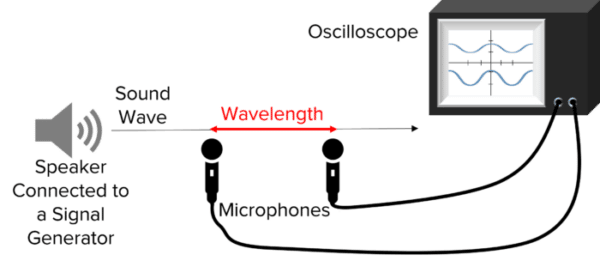Measuring Waves
Measuring Waves Revision
Measuring Waves
Different techniques are used to measure different types of waves. You need to know how to carry out the following experiments.
Measuring Sound Waves
The following experiment can be used to measure the speed of sound:
- Set up the oscilloscope so that each of the microphones are connected separately.
- Turn on the signal generator and make a note of the frequency, f that you have chosen.
- Begin with both microphones next to the speaker. The waves on the oscilloscope should line up, as shown in the diagram.
- Move one microphone away from the other slowly. As it moves away, the waves on the oscilloscope will change.
- When the waves on the oscilloscope line-up again, stop moving the microphone. The distance between the microphones is the wavelength, \bold{\lambda} of the sound.
- Measure the distance between the two microphones using a meter rule.
- Calculate the speed of sound using \bold{\text{v}=\text{f}\lambda}.

Required Practical
Measuring the Speed of Water Waves
This is a simple method for measuring the wavelength and speed of water waves. From this, you can calculate the frequency and period of the waves.
Doing the experiment

- In a darkened room, set up the experiment as shown in the diagram.
- Switch on the signal generator so that the dipper produces waves.
- Using the meter ruler, measure the distance between the shadows of the waves on the screen.
- Choose two points on the screen and measure the distance between them.
- Using a stopwatch, measure the time taken for a wave to travel between the two points.
- Calculate the speed of the wave using \text{speed}=\dfrac{\text{distance}}{\text{time}}.
Measuring Waves Example Questions
Question 1: A student sets up an experiment to measure the speed of sound using a signal generator, two microphones and an oscilloscope. They slowly move the microphones apart until the waves on the oscilloscope align. This occurs when the microphones are 10 \text{ cm} apart. What is the wavelength of the sound?
[1 mark]
Therefore \lambda = \bold{10\textbf{ cm}}
Question 2: Describe an experiment to measure the wavelength of water waves.
[6 marks]
In a darkened room, set up a wave tank with a dipper connected to a signal generator to create water waves.
Place a screen under the wave tank and a lamp above the wave tank. Switch on the signal generator.
Use a metre ruler to measure the distance between shadows of the waves on the screen.
Question 3: How could you use the experiment from Question 2 to calculate the frequency of the waves?
[4 marks]
Measure the distance between two points on the screen using the metre ruler.
Then use a stopwatch to measure the time it takes for a wave to go from one point to another.
Calculate the speed of the wave using \bold{\text{speed}=\dfrac{\text{distance}}{\text{time}}}.
Then calculate the frequency of the wave using \text{frequency}=\dfrac{\text{speed}}{\text{wavelength}}.





